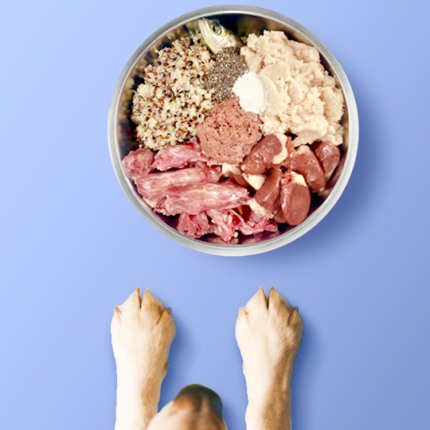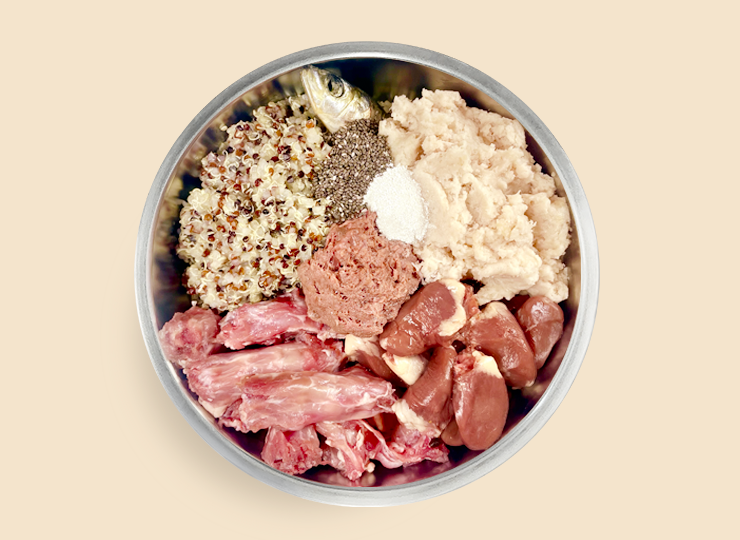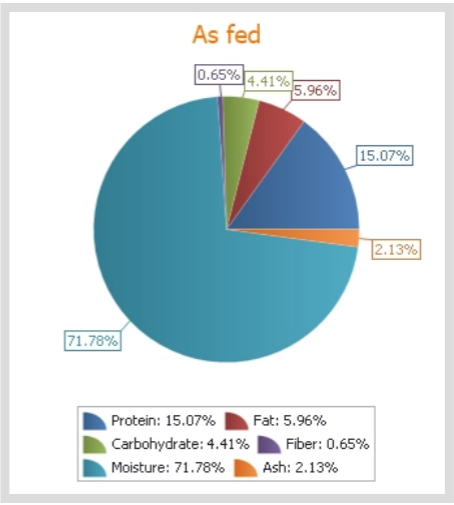DIY Raw Meal for Dogs and Puppies: Introduction to Raw Feeding

DIY Raw Meal for Dogs and Puppies: Introduction to Raw Feeding
For those who prefer to fully take the reins on their journey to Truly Raw, we’ve partnered with a certified canine nutritionist to create our DIY Raw Recipes series. These meals incorporate our DIY Parts products and other raw ingredients and are step-by-step recipes that you can follow to ensure you’re feeding your pet a complete and well-balanced raw meal.
A low-fat recipe for pet parents who are seeking to transition from processed pet food to raw DIY meals for their dog or puppy. This recipe is balanced to AAFCO and NRC nutritional guidelines for All Life Stages by our in-house certified canine nutritionist. This recipe is complete and balanced as it is written, and any ingredient changes or substitutions can affect the balance of the recipe.
Batch Recipe Ingredients

- Carnos Boneless Ground Chicken – 1,922g
- Carnos Chicken Necks – 2,300g
- Carnos Chicken Hearts – 1,200g
- Carnos Beef Organ Mix – 350g
- Carnos Whole Sardines – 200g
- Quinoa, cooked and mashed – 1,200g
- Chia seeds, ground – 40g
- NOW Full Spectrum Mineral Capsules – 25 pills
- NOW Iron Bisglycinate, 18mg – 6 pills
- NOW Kelp powder – 3 scoops
- NOW Vitamin E dry capsules – 3 pills
Recipe total yield = 254 ounces = 15.9 pounds
Recipe calories per ounce = 39.1 kcal/ounce
Recipe macronutrients = 15.1% protein, 5.96% fat, 4.41% carbohydrate (This recipe is low in fat. Therefore, it can be appropriate for most dogs who require a low-fat diet.

Required Prep Supplies
- Meal containers
- Adequate freezer space
- Food-safe cutting board
- Knife
- Kitchen food scale
- Spice grinder
- Potato masher
How to calculate appropriate feeding amounts for your dog.
A very general guideline for calculating feeding amounts:
Adult dogs: 2% of bodyweight for inactive dogs, 2.5% of bodyweight for most average dogs, and 3-4% of bodyweight for highly active dogs.
Puppies: puppies will typically start at 8-10% of bodyweight at 8-10 weeks of age. The percentage will slowly decrease as their weight/age increases. You want to feed enough that your puppy is not underweight, but not enough to make them chubby.
Example: 45 pound normal adult dog at 2.5% = 18 ounces of food per day
*Every dog and their metabolism is an individual. Feeding amounts should be adjusted as needed. If a dog is too thin and health issues have been ruled out, increase daily food. If a dog is too heavy and health conditions have been ruled out, decrease food within reason.
Meal Prep Instructions
- Calculate how many days the recipe will last your dog. The batch can be doubled or tripled if desired. Set out the required amount of tupperware or bento boxes to hold meals. For example: if your dog eats approximately 1lb per day, the recipe as is would last about 16 days, and you would need 16 containers that are large enough to hold 1 pound of food. Larger dogs will need larger containers and feeding amounts, while smaller dogs will need smaller containers and amounts.
- Thaw meat ingredients. Cook quinoa until soft, then mash with a potato masher. An instant pot works particularly well for cooking quinoa or rice.
- Grind seeds for optimal digestion in a spice grinder. Place in a bowl and add the powder supplements (open any capsules). Mix seed powder and supplements thoroughly
- Measure out total amount of mashed quinoa. Slowly sprinkle and mix in the seed/supplement powder thoroughly.
- Portion out each ingredient as evenly as possible into the meal containers. Be sure that quinoa is cooled before adding to meal containers with meat ingredients.
- Place 2-3 containers in the refrigerator and store the rest in the freezer. Remove 1 container from the freezer each day as 1 thawed container is used. Daily containers can be split into 2 meals per day if desired.
- An alternative prep method would be to use a grinder that can handle meat and small meaty bones or use our ground turkey necks. Then add all total ingredients to a large bussing bin or tub and mix together thoroughly, then portion as needed. *Do not grind in sardines due to thiaminase. When making a ground batch, add the sardines whole at meal time.*
Prepping pro tip: Use the total weight of ingredients rather than weighing each daily amount for each ingredient. In the example of prepping this recipe for 16 days, take the total grams of organ and divide into meal containers as equally as possible. No need to weigh ingredients individually for each day.
Nutritionist tip: As defined by nutritional guidelines AAFCO, NRC and FEDIAF dogs do not have a requirement for starchy carbohydrates. However, while carbohydrates like quinoa are not usually necessary, they are included here in this transition recipe for an important reason. Processed pet food is very high in carbohydrates. However, the average homemade raw diet is low-carbohydrate. When switching quickly from a high-carb diet to a low-carb diet, some digestive upset can occur. This recipe seeks to avoid digestive upset by using a bland white meat, low fat, and higher carb to ease the transition from processed pet food. A normal raw diet with no starchy carbs and higher healthy fats can then be utilized once your dog is fully transitioned and having consistent, healthy stools on this recipe